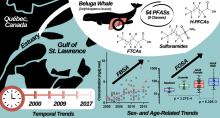| Title | Isomer-specific trophic transfer of perfluorocarboxylic acids in the marine food web of Liaodong Bay, North China. |
| Publication Type | Journal Article |
| Year of Publication | 2015 |
| Authors | Zhang, Z, Peng, H, Wan, Y, Hu, J |
| Journal | Environ Sci Technol |
| Volume | 49 |
| Issue | 3 |
| Pagination | 1453-61 |
| Date Published | 2015 Feb 03 |
| ISSN | 1520-5851 |
| Keywords | Animals, Bays, Birds, Carboxylic Acids, China, Environmental Monitoring, Fishes, Fluorocarbons, Food Chain, Invertebrates, Isomerism, Water Pollutants, Chemical |
| Abstract | Trophic transfers of perfluorocarboxylic acids (PFCAs) have been well studied in aquatic food webs; however, most studies examined PFCAs as single compounds without differentiating isomers. In this study, an in-port derivatization GC-MS method was used to determine PFCA (perfluorooctanoic acid, PFOA; perfluorononanoic acid, PFNA; perfluorodecanoate acid, PFDA; perfluoroundecanoate acid, PFUnDA; perfluorododecanoate acid, PFDoDA; perfluorotridecanoate acid, PFTriDA, and perfluorotetradecanoate acid, PFTeDA) structural isomers in 11 marine species including benthic invertebrates, fishes, and gulls collected in November 2006 from Liaodong Bay in China. The total concentrations of linear PFCAs were 0.35-1.10, 0.93-2.61, and 2.13-2.69 ng/g ww, and the corresponding percentages of branched PFCAs to linear PFCAs were 6.6-15.5%, 4.2-9.9%, and 4.5-6.0% in invertebrates, fishes, and birds, respectively. Except for linear PFOA, significant positive relationships were found between the concentrations of all the target linear PFCAs and trophic levels, and the trophic magnification factors (TMFs) ranged from 1.90 to 4.88. Positive correlations between the concentrations of branched PFCAs isomers and trophic levels were also observed but were without statistical significance. The relatively high biomagnification of linear isomers of PFCAs would lead to low percentages of branched PFCAs to total PFCAs in organisms at high trophic levels. This study for the first time clarified isomer-specific trophic transfers of PFCAs in a marine food web. |
| DOI | 10.1021/es504445x |
| Alternate Journal | Environ. Sci. Technol. |
| PubMed ID | 25575072 |
Environmental Chemical Biology

